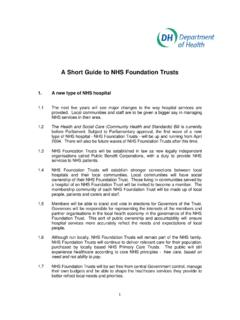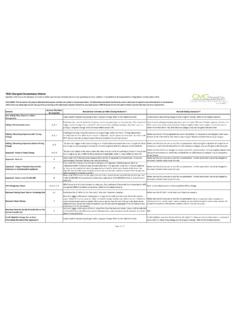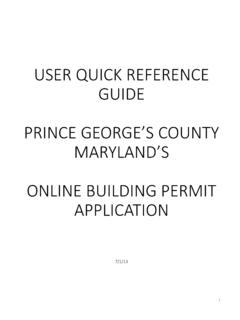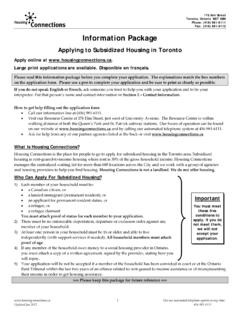Transcription of GIS for Asset and Facilities Management - Esri …
1 GIS for Asset and Facilities ManagementEfficient Management of Assets, Interior Space, and the Building Life CycleWhere Are Your Assets?One of the biggest costs to an organization, second only to human resources, is Asset and Facilities Management . If these are managed well, an organization can reduce its overall business costs through more efficient maintenance, managing space more effectively, and locating and using resources in the most efficient manner. To do this effectively, it is important to understand where real property, such as offices, warehouses, vehicles, pipelines, computers, and desks, are located.
2 Using geographic information system (GIS) software to do this gives users a more accurate reflection of real-world circumstances and allows organizations to make better business can be used throughout the life cycle of a building for more efficient Asset and Facilities National Institute of Building Science estimates that Facilities consume 40 percent of the world s energy. Carnegie Mellon University research has indicated that improving productivity in building functions by just percent would pay for a facility s design, construction, operations, and sustainment.
3 GIS brings this efficiency to Facilities allows organizations to use the same data and software to see their facility information across all Is GIS?GIS combines location data with both quantitative and qualitative information about the location, letting you visualize, analyze, and report information through maps and charts. Using the technology, you can answer questions, conduct what-if scenarios, and visualize is often first identified as a system to manage infrastructure assets and natural resources outside of buildings, but this is only part of the story.
4 Buildings, campuses, military bases, and industrial plants, to name a few, also have geography and can be mapped. It is easier to analyze and manage facility and Asset data stored in GIS, making design, construction, and maintenance more efficient and Use GIS?GIS can integrate with and extend your current Facilities Management (FM) system. Maintaining and managing all your disparate Facilities and assets in GIS means everyone in your organization knows their location and status. Data can be updated quickly, work orders created efficiently, and space used more the same data throughout a project is more efficient, cuts down on errors, and allows everyone to be on the same an Established Community of UsersMapping, managing, and analyzing information about interior spaces and their assets are not new.
5 For decades, Esri customers in health care, defense, commercial real estate, and finance have used GIS to make smarter decisions regarding the use and maintenance of space. GIS has been a core component of these organizations information systems, supporting numerous workflows, integrating with other systems, and providing a better understanding of Meeting compliance codes ensures that a building or Asset is safe and operates as intended. Building compliance can span from energy efficiency, safety, and zoning to issues dealing with conformity to laws such as the Americans with Disabilities Act (ADA) of 1990.
6 Buildings and assets are inherently spatial; they are located somewhere on the earth. GIS can be used to efficiently collect and store information based on their location, providing a means for query, analysis, and reporting when Management and MaintenanceGIS helps organizations gain efficiencies even in the face of finite resources and the need to hold down costs. Operations and maintenance staff can deploy enterprise and mobile workforce applications that provide timely information to the field for faster, more accurate work order processing.
7 Lease and Property Management Revenue can be increased and operations and maintenance costs reduced when GIS helps manage space. Real estate and property managers can see and make queries about space including its availability, size, and special constraints for the most cost-effective thousands of hours of labor by calculating building space and usage in a single building or across an entire base like the Army Corps of Engineers, Fort Worth District, Texas. Dewberry & Davis helped the installation get a handle on data accuracy, integrity, and paperwork with its AMMO-FM Usage GIS helps Facilities managers organize and spatially visualize space and how it can best be used.
8 Operational costs can be decreased by more efficiently using space including managing the moves of personnel and assets as well as the storage of and Business Continuity PlanningViewing buildings and the locations of assets along with emergency information, such as weather patterns and disaster zones, can give organizations the information they need to make decisions quickly. GIS provides a holistic understanding of facility status and performance and brings together departments, business systems, and data sources for a comprehensive view into and throughout organizations.
9 Green Buildings Increase a facility s sustainability by using GIS to help reduce energy and water use, find better waste disposal, and decrease a building s carbon footprint. By managing information both inside and outside buildings down to the Asset level, a difference can be made in the environmental impact of Applications for FMCity College of San FranciscoAttended by more than 100,000 students each year, City College of San Francisco (CCSF) maintains and uses 300 Facilities spread across 11 campuses in the city of San Francisco, California.
10 CCSF is one of the largest community colleges in the country, and the college confers the most associate degrees in arts and sciences in the state of California. CCSF worked with i-TEN Associates, Inc., an Esri partner located in Berkeley, California, to create a centralized and flexible GIS for organizing and delivering facility information, particularly to assist the college with correctly identifying the current level of physical accessibility to all classrooms and buildings according to the ADA. GIS provides access to ADA information at all campuses in the district.






